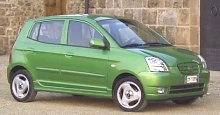|
 Korean
car industry has been growing rapidly during the last decade. Not only
Hyundai group became one of the world's top 10 car makers, but the
quality
of products also reflect its rising trend. Today's Korean cars are
still
cheaper than their rivals, but they are far more competitive than
before
in other areas such as styling, build quality, comfort and dynamics.
Following
the footprints of Hyundai, its subsidiary Kia is also going the quality
route. However, until now all of the "New Age" Kia are derived from
equivalent
Hyundai models, for example, Cerato is derived from Hyundai Elantra,
Opirus
is converted from Hyundai Equus, Optima is simply a reskinned Hyundai
Sonator.
Now the first self-developed New Age Kia is finally born - Kia Picanto.
It uses a new platform and, at least for now, not sharing with any
Hyundai
models. Korean
car industry has been growing rapidly during the last decade. Not only
Hyundai group became one of the world's top 10 car makers, but the
quality
of products also reflect its rising trend. Today's Korean cars are
still
cheaper than their rivals, but they are far more competitive than
before
in other areas such as styling, build quality, comfort and dynamics.
Following
the footprints of Hyundai, its subsidiary Kia is also going the quality
route. However, until now all of the "New Age" Kia are derived from
equivalent
Hyundai models, for example, Cerato is derived from Hyundai Elantra,
Opirus
is converted from Hyundai Equus, Optima is simply a reskinned Hyundai
Sonator.
Now the first self-developed New Age Kia is finally born - Kia Picanto.
It uses a new platform and, at least for now, not sharing with any
Hyundai
models.
Being
called
"Morning" at
home, Picanto is destined to Europe, the toughest battleground for mini
cars. If it could succeed there, it could also win at anywhere else.
According
to the comments by European car testers, the sign is pretty good.
 No
one knows where Picanto was styled. Korean car makers prefer to employ
Italian styling houses but they don't like to let you know. The
exterior
design looks very much like European mini cars. It's pretty without
being
special, except the odd grille. The fat profile encloses a spacious
cabin.
4 adults can sit comfortably. In particular, rear passengers enjoy more
generous legroom than its strongest rival, Fiat Panda, though the
swoopy
roofline doesn't offer as much headroom. The trunk volume measures only
157 litres. Luckily, rear seats can be folded to increase luggage
volume
to 882 litres. Better still, the load floor is flat when the seats are
folded. No
one knows where Picanto was styled. Korean car makers prefer to employ
Italian styling houses but they don't like to let you know. The
exterior
design looks very much like European mini cars. It's pretty without
being
special, except the odd grille. The fat profile encloses a spacious
cabin.
4 adults can sit comfortably. In particular, rear passengers enjoy more
generous legroom than its strongest rival, Fiat Panda, though the
swoopy
roofline doesn't offer as much headroom. The trunk volume measures only
157 litres. Luckily, rear seats can be folded to increase luggage
volume
to 882 litres. Better still, the load floor is flat when the seats are
folded.
It is sad to
see
the design
of dashboard and console are so outdated while the plastic materials
cannot
match the Fiat. The driver's seat cannot be adjusted up and down, so
you
need to adjust the steering column instead. Visibility of mini cars is
often good, this one is without exception.
 Predictably,
the chassis is conventional monocoque while suspension is MacPherson
strut
up front and torsion-beam at the rear. As the Picanto was tweaked on
European
and UK roads, it is not as softly sprung as most Japanese K-cars,
giving
it European-style body control and ride character. Nevertheless, its
ride
cannot match the suppleness of Fiat Panda and the best European minis.
It feels most at home in town traffic, thanks to light steering and
smooth
gearshift, but on highway it also runs stable and quiet. Predictably,
the chassis is conventional monocoque while suspension is MacPherson
strut
up front and torsion-beam at the rear. As the Picanto was tweaked on
European
and UK roads, it is not as softly sprung as most Japanese K-cars,
giving
it European-style body control and ride character. Nevertheless, its
ride
cannot match the suppleness of Fiat Panda and the best European minis.
It feels most at home in town traffic, thanks to light steering and
smooth
gearshift, but on highway it also runs stable and quiet.
The 1.1-litre
four-cylinder
engine has only a single camshaft and 3 valves per cylinder. In
addition
to long stroke design, it produces just 65 horsepower. This car is
therefore
never fast, but the maximum 69lbft of torque arrives at just 2800rpm,
sparkling
its performance in town. However, it cannot match Fiat Panda's Super
Fire
engine in refinement, because it gets noisy and coarse at high rev.
Although
Picanto
does not
have any single area outstanding, its overall package is competitive.
Unlike
most other Korea cars, it is quite fun to drive. In addition to the low
price / high equipment level advantage, it is likely to attract a lot
of
customers. |